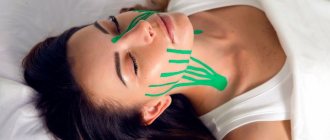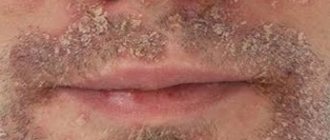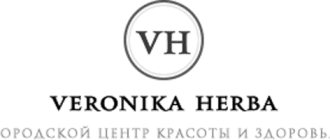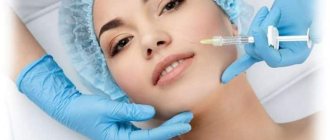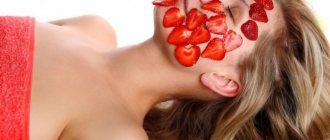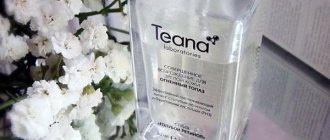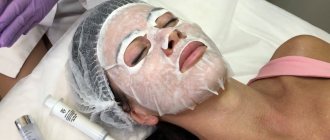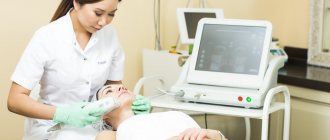Rosacea
Rosacea
is a persistent lesion of the blood vessels of the facial skin. It manifests itself as redness of the skin of the cheeks, nose, forehead and chin, bright pink rashes, spider veins, and pustules. In later stages, irreversible thickening and infiltration of the skin of the nose, forehead, earlobes, eyelids, and chin may develop. Leads to a deterioration in the appearance of the skin, sometimes pronounced cosmetic defects, changes in appearance, and psycho-emotional problems. When the eyes are affected, keratitis and ulceration of the cornea develop.
Previously, the development of rosacea was attributed to the presence of demodicosis, but these two diseases are different in their etiology, although each of them complicates the course of the other. The pathogenesis of the development of rosacea lies in the increased sensitivity of skin vessels. If there is a genetic predisposition or the vessels are fragile and brittle, then in response to irritants such as sudden changes in temperature, dry and hot air, the vessels dilate, which is not observed in the majority of people.
The incidence of rosacea in people with a history of gastritis is much higher than in those in whom Helicobacter pylori, the bacterium that causes gastritis, has not been detected. Rosacea of a medicinal nature is observed with long-term use of corticosteroid ointments; the skin arteries become thinner, become more fragile and sensitive to minor temperature changes.
Clinical manifestations
Localization : has a characteristic location of the rashes, these are the perioral zone, nasolabial folds, skin of the chin and cheeks. The affected areas are characterized by symmetry.
Characteristic sign : a strip of healthy skin around the lips measuring 2-4 mm (characteristic in most cases, however, the case shown in the photo is a rare exception).
Rashes : pinkish-red papules, papulo-vesicles and papulo-pustules measuring 1-2 mm are located on an erythematous (red) background. Rashes are resolved by the appearance of crusts in place of the papules. The skin is dry, swollen.
Subjective sensations: characterized by a feeling of skin tightness, itching and burning.
Outbreaks of erythema with temperature changes, alcohol intake, spicy and hot foods. These manifestations are also characteristic of rosacea, which complicates the diagnosis of perioral dermatitis.
pigmentation may develop .
Prevention of rosacea
Since rosacea is a chronic disease, after removing the excess capillary network, it will reappear after some time. Therefore, the prevention of rosacea consists of periodic visits to the cosmetologist’s office to eliminate newly appeared hypertrophied blood vessels. But, if between procedures you avoid overheating and hypothermia of the skin, spend as little time in the open sun as possible, adjust your diet and use cosmetics that contain horse chestnut extract and other substances that strengthen the vascular wall, then you will need to repeat the procedures no more than once every 2 -3 years.
Perioral dermatitis
Perioral dermatitis
- chronic inflammatory lesion of the skin around the mouth in the form of individual or grouped red papules located against the background of normal or reddened skin.
Perioral dermatitis is most often observed in women aged 20 to 40 years. Recently, there has been an increase in the incidence of this type of dermatitis among children.
Causes
The exact causes of the development of perioral dermatitis are not known, but trigger factors have been identified, i.e. provoking:
- Deterioration, weakening of immunity;
- Climate change;
- Exposure to ultraviolet rays;
- Use of corticosteroids;
- Fluoridated toothpaste;
- Genetic predisposition;
- The use of low-quality cosmetics against the background of a tendency to allergic reactions to cosmetics;
- Emotional stress.
The most reliable seems to be the development of perioral dermatitis in connection with long-term local use of corticosteroid ointments against the background of other provoking factors. There is a decrease in local immunity, which gives impetus to the development of the inflammatory process.
Risk factors for the development of rosacea
The incidence of rosacea is approximately the same in both sexes, but women during menopause are more susceptible to rosacea, as hormonal levels and vascular properties change. Blondes and redheads with thin, sensitive skin prone to redness are at risk for rosacea. Allergic and contact dermatitis can provoke rosacea, since the blood vessels are often dilated and subsequently their return to their previous state is no longer possible.
Genetically, residents of northern peoples are more predisposed to rosacea; living in extreme continental climates and in northern countries also increases the risk of rosacea.
Diseases and disorders of the endocrine system, diseases of the gastrointestinal tract and disorders of the immune system, especially when combined with each other, lead to rosacea. The pathogenesis of rosacea is not fully understood, but most dermatologists agree that exposure to hot or cold areas, wind, and consumption of excessively burning foods, alcohol and spices provoke rosacea.
Principles of therapy
For a pronounced therapeutic effect, an integrated approach is required in the correction of perioral dermatitis.
It is important to understand that the duration of therapy is quite long and takes from 6 to 8 weeks .
STAGE 1 – strict adherence to these recommendations
- Using fluoride-free toothpastes.
- If a course of external corticosteroids (hormonal ointments) was prescribed, complete use.
- Avoid the use of decorative cosmetics, especially in the rash area.
- Cleansing the skin only with specialized hypoallergenic products. For example, DermaQuest Cleansing Milk for Delicate Skin is designed for daily cleansing of dry, irritated, sensitive and dehydrated skin.
Heals dry and sensitive facial skin, giving the skin a feeling of comfort, cleanliness, and velvety.
- Compliance with a special dietary regimen that excludes the intake of hot, spicy foods and alcohol.
STAGE 2 – dermatological treatment
It is prescribed by a dermatologist after diagnosis and includes individual prescription of antihistamines, diuretics, sedatives, and sometimes antibiotic therapy.
BIBLIOGRAPHY _
Akbulatova L.H. The pathogenic role of the Demodex mite and clinical forms of demodicosis in humans. // Bulletin of Dermatology, 1996, 2, pp. 57-61.
Akilov, O.E., Vlasova I.A., Kazantseva S.V., Features of the immune response in patients with dermatoses complicated by severe infestation of anthropophilic mites of the genus // Immunology. 2002. - No. 1. P.43-47
Ambartsum, AM Treating demodicosis / AM Ambartsum // New pharmacy. 2007. -№7. — P.32-35
Beridze, L.R. Changes in immune parameters in primary and secondary demodicosis of the skin // Georg. Med. News. 2004. - No. 6 - P.43-45
Bobrov V.M. Rosacea of the nose, complicated by demodicosis. Bulletin of Dermatology and Venereology 1994; 4:43-44
Butov, Yu.S., Akilov O.E. Clinical features and issues of classification of demodicosis of the skin // Ros. magazine skin and venereal diseases. 2003. - No. 2. — P.53-58
Vartapetov A.Ya. Follicular demodex in skin pathology. // Abstract report at a scientific-practical conference, Moscow Research Institute of Cosmetology of the Ministry of Health of the RSFSR. M., 1972, pp. 38-39
Vasilyeva M.S., Lange A.B. Iron mite populations in perioral dermatitis and rosacea. M: 2006; 135
Vasilyeva M.S., Shif L.V., Vardoyants S.A., Kanbarova L.I. About some clinical manifestations of demodicosis: New cosmetic preparations and treatment of diseases and cosmetic defects. Sat. scientific works of the hospital named after. Y.M.Sverdlova. L 1970; 45-48
Verkhoglyad I.V. Modern antiparasitic therapy of demodicosis // Clinical. dermatology and venereology. 2006. - No. 4. — P.89-90
Vostroknutova T.M. , Mokronosova M.A., Iron mites and problematic facial skin // Attending physician. -2007. No. 9. — pp. 10-12
Zhsltikova, T.M. Is demodicosis a diagnosis or a symptom? // Medical Bulletin. - 2006. - No. 38. — P. 16
Clinical recommendations, Dermatovenereology /edited by A.A. Kubanova// M.: DEX-Press, 2010.-206-209, 230-233
Kogan B.G., Gorgol V.T. Specificity of Demodex folliculorum and Demodex brevis mites, the causative agents of human demodicosis. // Ukrainian Journal of Dermatology, Venereology, Cosmetology, 2001, 21, pp. 37-41.
Kogan, B.G., Gorgol V.T. Diagnosis of demodicosis // Dermatology. Cosmetology. Sexopathology, - 2008. No. 1-2 (11).- P. 286-287
Koshevenko, Yu.N. Demodicosis pseudo-problem of dermatocosmetology // Ros. magazine skin and venereal diseases. - 2004. - No. 4. — P. 6469
Loshakova, V.I. Demodicosis is an urgent problem of modern dermatocosmetology // Vestn. postgraduate honey. education. — 2001. -№1. - pp. 79-80
Petrosyan E.A., Petrosyan V.A. Treatment of rosacea complicated by demodicosis with blood extracorporeally modified with sodium hypochlorite. Vestn Dermatol 1996;2:42-44.
Polunin G.S., Kasparova E.A., Polunina E.G.: Clinical effectiveness of blepharogels in the prevention and treatment of blepharitis. New in ophthalmology No. 1, 2004, pp. 44-47
Akilov OE, Mumcuoglu KY Immune response in demodicosis. //J Eur Acad Dermatol Venereol., 2004, v.18, N4, p.440-444
Aylesworth R., Vance JC Demodex foliculorum and Demodex brevis in cutaneous biopsies. //J.American Academy of Dermatology, 1982, v. 7, n. 5, p. 583-589
Ayres J, Ayres S (1961) Demodecidosis in the human. Arch Dermatol 83:816–27
Bassiouni SO, Ahmed JA, Younis AL, Ismail MA, Saadawi AN, Bassiouni SO A study on Demodex folliculorum mite density and immune response in patients facial dermatoses. // J. Egypt Soc. Parasitol., 2005, v.35, N3, p.899-910
Forton F., Cermaux M.A., Brasser T. Et al. Demadecosis and rosacea: epidermiology and significance in daily dermatologie practice. J Am Acad Dermatol 2005; 1:74-87
Forton F., Seys B. Density of Demodex follicolorum in rosacea: a case-control study using standardized skin-surface biopsy. // British J. of Dermotology, 1993, v.128, p.650-659
Kligman AM, Christensen MS Demodex folliculorum: Requirements for Understanding Its Role in Human Skin Disease. Journal of Investigative Dermatology. 2011; 131:8–10
Kogan BG, Stepanenko VI, Gorgol VT, Pavlyshin AV Role of Demodex mites and Helicobacter infection in etiopathogenesis of rosacea, demodicoses, perioral dermatitis and acne disease. Eur Acad Dermatol Venerol 2003; 15(3): 165.
Lacey N, Kavanagh K, Tseng SC. Under the lash: Demodex mites in human diseases. Biochem (Lond). 2009; 31(4): 2-6
Nutting WB Pathogenesis associated with hair follicle mites (Acari: Demodicidae) // Acarologia, 1975, V.17, p.493-507
Rodriguez AE, Ferer C, Alio JL Chronic blepharitis and Demodex. //Arch. Soc. Esp. Oftalmol, 2005, v; 80, N11, p. 635-42
Rufli T., Mumcuogly Y. Tile hair follicle mites Demodex folliculorum and Demodex brevis: biology and medical importance // Dermatolog., 1981, p.162
What can you eat?
There is an opinion that food restrictions and radical reductions in diet can cure dermatitis. In fact, eliminating all potentially hazardous foods may not only be ineffective, but also dangerous to health. A diet low in allergenic foods does improve skin condition, but doctors are extremely careful about developing the right diet for each patient. In addition, there is scientific evidence that the frequency of exacerbations and severity of dermatitis is influenced not only by food, but also by other factors directly or indirectly related to the therapeutic diet. Therefore, when developing diets, doctors propose the following approach to treating the disease:
- Maintaining normal body weight. Among adults who are overweight or obese, the risk of the disease is 29% and 56% higher, respectively, compared with adults of normal weight.[2]
- Prebiotics, probiotics and synbiotics. Research has shown that the use of synbiotics (a combination of prebiotics and probiotics) also has a positive effect on skin health.[3]
- Fatty acids and vitamin D supplements: There is evidence that taking vitamin D and omega acids improves skin conditions in people with eczema. This is due to the fact that these substances have anti-inflammatory activity.
Therefore, if we talk about the correct diet for dermatitis, you need to understand that diet is only part of the treatment. It is important not to get hung up on what you can or cannot eat, but to concentrate on the principles of a healthy lifestyle. Dietary nutrition for dermatitis has its own characteristics, so patients will have to adjust their lives to them. The basic principles include:
- meals 5-6 times a day in small portions;
- exclusion of allergenic foods such as nuts, citrus fruits, chocolate, exotic fruits and foods with dyes and harmful food additives, red vegetables and fruits;
- boiling, stewing, baking or steaming foods;
- reducing salt consumption, avoiding sweets, spices, spicy and fatty foods;
- increasing the volume of fluid consumed to 2-2.5 l;
- daily calorie content of food is at the level of 2500-2800 kcal.
Authorized Products
When following a diet for dermatitis, it is better to bake, boil and stew foods with a minimum of oil. To control your diet, we recommend keeping a food diary in which you write down everything you eat during the day. Patients with dermatitis can freely eat:
- boiled or steamed beef meat, boiled;
- cereal, vegetarian or recycled beef broth soups;
- sunflower and olive oil.
- boiled potatoes;
- buckwheat, rice and rolled oats;
- natural yoghurts without additives;
- fermented milk products - cottage cheese, fermented baked milk, yogurt;
- baked apples;
- dried fruit compotes (except raisins);
- whole grain bread and crispbreads.[1]
Prohibited Products
First of all, it is necessary to completely exclude fried foods, smoked foods, everything spicy and salty, as well as semi-finished meat and fish products from the diet.
To successfully treat dermatitis, patients should eliminate from their daily diet:
- coffee and sweet carbonated drinks;
- alcoholic drinks;
- spices and sauces (vinegar, mustard, ketchup, mayonnaise);
- horseradish, radish and radish;
- hot and sweet peppers, tomatoes, eggplants;
- milk;
- eggs;
- chocolate and chocolate confectionery;
- baked goods, yeast;
- honey;
- fish and seafood;
- poultry and dishes from goose, duck, chicken;
- nuts;
- citrus fruit;
- berries and fruits of red or orange color.[1]
